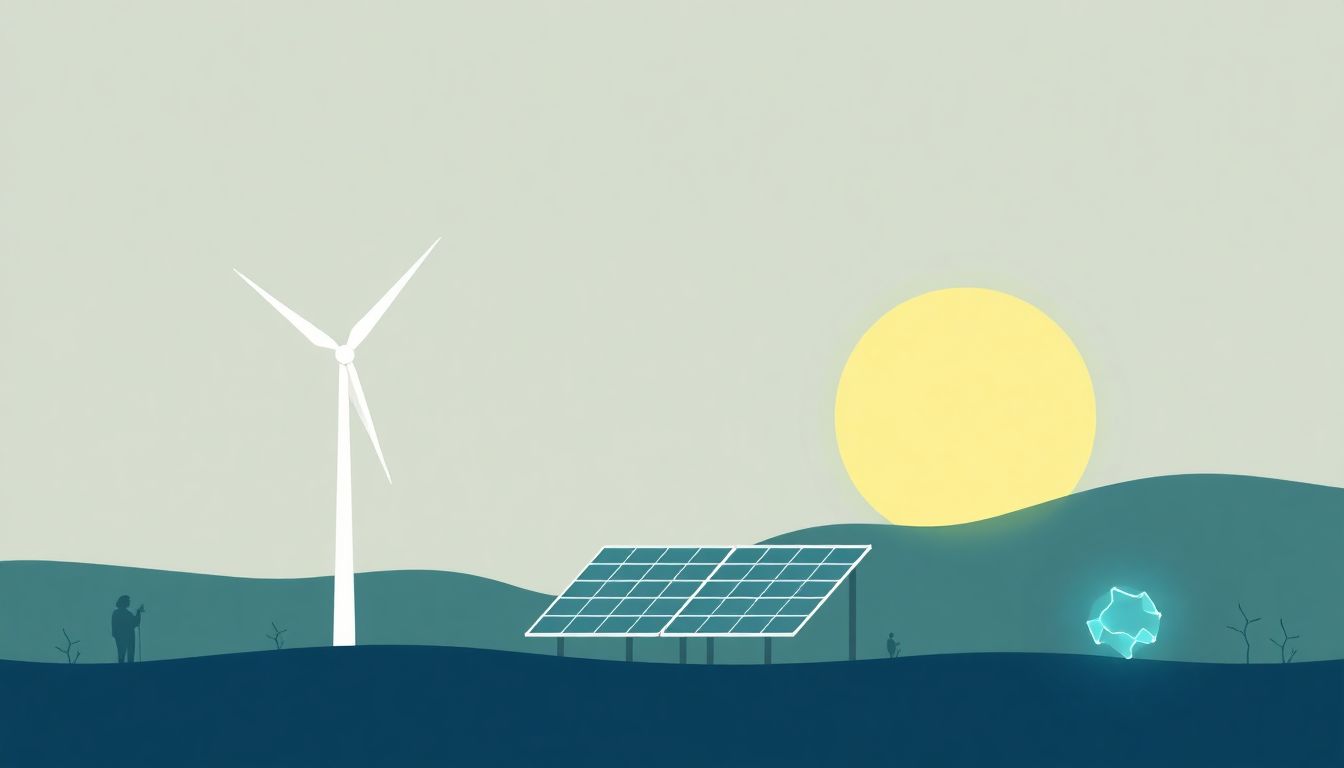AI is changing how we use renewable energy, making it smarter and more effective. Many people worry about whether AI can truly help the environment or just add to the tech clutter. But if you keep reading, you’ll see how AI actually offers practical ways to boost clean energy, save costs, and keep the lights on smoothly.
In the next few pages, I’ll show you how AI supports renewable energy in 2025, helps companies improve projects, and even enhances grid stability. Plus, we’ll look at challenges and real steps you can take to make AI work better for sustainable power.
Key Takeaways
Key Takeaways
- By 2025, AI makes renewable energy more efficient and reliable by predicting weather, optimizing energy storage, and discovering better materials for solar and wind tech. This helps reduce waste and speeds up the switch to cleaner power.
- AI platforms improve project planning by analyzing site data and forecasts, guiding where to build and when to perform maintenance. This saves money and boosts energy output.
- Using AI sensors and algorithms helps cut costs by monitoring performance, scheduling energy flow, and reducing the need for backup fossil fuels. Partnering with AI specialists can boost results.
- AI enhances grid stability by predicting demand, managing loads, and quickly fixing faults. This prevents outages and makes it easier to shift toward renewable sources from fossil fuels.
- Challenges include poor data quality, high upfront costs, and cybersecurity risks. Solutions involve investing in good sensors, starting small, and collaborating with experts for better results.
- Making AI sustainable involves designing energy-efficient models, using renewable-powered data centers, and sharing tools openly to save resources and lower carbon footprints.
- Policies and research set standards for responsible AI use in energy, promoting transparency and fairness. Industry participation ensures solutions meet future standards and ethical goals.
- To use AI successfully, start with clear goals, gather quality data, test small projects, train staff, and stay updated on regulations. Taking gradual steps helps maximize benefits and reduces risks.

1. How AI Supports Renewable Energy in 2025
By 2025, AI plays a key role in making renewable energy more efficient and reliable. It helps predict weather patterns better, which means solar and wind farms can plan their energy output more accurately. This reduces waste and ensures a steady supply of clean power.
AI algorithms analyze huge amounts of data to optimize how energy is stored and distributed across grids. For example, AI can forecast peak demand times and adjust generation accordingly, preventing overloads or shortages. Companies like Google are investing billions to power their data centers with renewable energy, relying heavily on AI to manage these complex systems.
Another way AI boosts renewables is by discovering new materials for solar panels or wind turbines, making these technologies more efficient and cheaper over time. As a result, AI is accelerating the shift toward a cleaner, greener energy future that could meet global demands without further increasing carbon emissions.
2. How AI Platforms Help Renewable Energy Companies Optimize Projects
AI platforms act as the brains behind renewable energy projects, making sure every dollar is spent wisely. They analyze site data—like wind speeds or sunlight hours—to identify the best locations for new farms. This helps developers avoid costly mistakes and speed up project development.
These platforms also simulate how different energy assets will perform over time, helping companies plan maintenance schedules and prevent equipment failures. For instance, AI tools can forecast when a wind turbine blade might need repairs, saving money and reducing downtime.
Popular AI platforms like SellAITool provide a marketplace where renewable energy companies can find AI-powered tools and assets to enhance their operations. Using these platforms, organizations streamline project management and maximize energy output with less guesswork.
3. Implementing AI for Better Energy Production and Cost Savings
If you want to ramp up your renewable energy game and cut costs, here’s how to do it with AI: start by integrating AI-powered sensors and analytics into your existing infrastructure. These tools help monitor performance in real-time, catching inefficiencies early.
Next, use AI algorithms to optimize the scheduling of energy generation and storage. For example, AI can decide when to charge batteries or feed power into the grid, based on predicted weather and demand patterns. This way, you reduce reliance on expensive backup fossil fuels.
To ensure success, consider partnering with AI specialists or platforms like [SellAITool](sellaitool.com) to access ready-made AI solutions or even sell your own AI-driven tools tailored for renewable energy. The bottom line: AI isn’t just a tech fad—it’s a tool to produce more energy at lower costs, helping your bottom line and the planet.

4. Using AI to Improve Power Grid Stability and Manage Supply
AI is becoming a go-to tool for keeping power grids steady, especially as the share of renewable energy grows.
It helps forecast grid loads more accurately, so energy providers can prepare for peak times and avoid blackouts.
AI models analyze real-time data from sensors, weather forecasts, and energy demand to predict disruptions before they happen.
This way, utilities can quickly reroute power or adjust generation, preventing outages and optimizing resources.
For example, companies are now deploying AI-based outage management systems that identify faults almost instantly and pinpoint where repairs are needed, speeding up restoration times.
Since about 60% of growing electricity demands from data centers are still powered by fossil fuels, AI can guide the transition toward cleaner options by balancing supply and demand smartly.
To get started, energy firms should explore platforms like GridAgents or Smap that specialize in AI-driven grid management tools.
5. Challenges of AI in Renewable Energy and How to Address Them
While AI offers many advantages, implementing it in renewable energy systems isn’t without hurdles.
One big issue is data quality—if your sensors or systems send inaccurate info, AI models may give you wrong predictions.
Another challenge is the sheer complexity of energy grids, which can make training AI software a daunting task.
There’s also the problem of high upfront costs and the need for skilled personnel who know both energy systems and AI tech.
Plus, as AI relies on large amounts of data, privacy and cybersecurity concerns come into play, especially when dealing with sensitive grid information.
To tackle these issues, companies should invest in high-quality sensors and regular maintenance to improve data accuracy.
Collaborating with research institutions or startups like Neptune.ai can help develop customized AI solutions while sharing costs.
It’s also useful to start small—pilot AI projects on a single site or component and learn from those before scaling up.
And don’t forget to prioritize security measures to keep your AI systems safe from cyber threats.
6. Making AI More Sustainable for Renewable Energy Systems
AI should support, not hinder, the goal of creating a sustainable future.
This means designing AI algorithms that are energy-efficient themselves, using less power to run.
Some AI models, especially deep learning ones, can be very resource-heavy, so optimizing them for low consumption is key.
Practices like pruning unnecessary calculations or deploying AI on specialized hardware can cut down energy use significantly.
Also, sourcing data and training models using renewable energy helps reduce the carbon footprint of AI development.
In addition, sharing data and AI tools openly across the industry can help reduce redundant efforts, saving resources overall.
For instance, open-source platforms like GitHub host AI projects that can be adapted and improved without starting from scratch.
By embedding sustainability into AI development, renewable energy providers can promote a cleaner, greener tech landscape.
7. How Policies and Research Shape Responsible AI Use in Energy
Policies and ongoing research are crucial in guiding how AI is applied in the energy sector responsibly.
Governments worldwide are setting standards for transparency, fairness, and safety when deploying AI systems.
Research institutions explore how to reduce bias in AI models and ensure they work well across different regions and grid configurations.
For instance, the European Union’s AI Act aims to create a framework for trustworthy AI, including high-risk sectors like energy.
Funding for research projects, like those from the DOE, promotes the development of AI tools that enhance grid stability without unintended consequences.
Industry groups are also creating best practices for integrating AI, sharing lessons learned, and avoiding pitfalls.
If you’re a renewable energy company, pay attention to policies in your country and participate in industry forums, so your AI strategies align with emerging standards.
Doing so ensures your investments are future-proof and your systems are ethically and environmentally sound.
8. Practical Steps for Renewable Energy Providers to Use AI Effectively
Getting started with AI might feel overwhelming, but breaking it down into steps can help you move forward confidently.
First, identify specific challenges or goals—do you want better weather forecasting, smarter maintenance, or grid management?
Next, gather and clean your data—quality info from sensors, weather stations, and operational logs is essential.
Then, look for industry-ready AI platforms like SellAITool that suit your needs, or partner with AI specialists who can customize solutions.
Start with small pilot projects—test AI tools on one wind farm or solar site and see what works best.
Monitor results carefully, tweak your models as needed, and gradually expand deployment.
Invest in training your staff so they can operate and maintain AI tools comfortably.
Finally, keep an eye on policy developments and industry trends, so your AI setup stays compliant and up-to-date.
Remember, the goal is to use AI to boost efficiency, cut costs, and support your company’s transition to cleaner energy—taking it step by step makes the journey smoother.
FAQs
AI is set to improve energy forecasting, optimize resource management, and enhance maintenance in renewable energy systems, leading to more reliable production and increased efficiency in 2025.
AI platforms analyze data to improve design, monitor performance, and predict issues, allowing companies to refine operations and lower costs across renewable energy projects.
Start with data collection, select suitable AI tools, train staff, and integrate AI into existing workflows to improve decision-making and operational efficiency.
Challenges include data quality and cybersecurity risks. These can be mitigated through robust data management practices and strong security protocols.